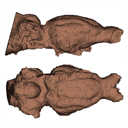

















| Plane | Position | Flip |
| Show planes | Show edges |
0.0
M3#857
endocast of the brain cavity
Data citation:
Maëva J. Orliac , Hugo Bouaziz and Romain Weppe
, 2021. M3#857. doi: 10.18563/m3.sf.857
Model solid/transparent
Flags:
cerebellar hemisphere, circular fissure, coronolateral sulcus, foramen ovale cast, hypoglosal foramen, internal acoustic meatus cast, jugular foramen, medula oblongata, mesencephalon, oblic sulcus, olfactory bulbs, optic chiasma, orbitotemporal canal, parafloccular lobe, presylvia, rhinal fissure, sphenorbital fissure, superior petrosal sinus, superior sagital sinus, suprasylvia, vermis

|
Brain damage: the endocranial cast of Mixtotherium cuspidatum (Mammalia, Artiodactyla) from the Victor Brun Museum (Montauban, France)Maëva J. Orliac, Hugo Bouaziz and Romain WeppePublished online: 25/11/2021Keywords: artiodactyl; Late Eocene; Quercy https://doi.org/10.18563/journal.m3.158 Abstract Our knowledge of the external brain morphology of the late Eocene artiodactyl ungulate Mixtotherium, relies on a plaster model realized on a specimen from the Victor Brun Museum in Montauban (France) and described by Dechaseaux (1973). Here, based on micro CT-scan data, we virtually reconstruct the 3D cast of the empty cavity of the partial cranium MA PHQ 716 from the Victor Brun Museum and compare it to the plaster model illustrated and described by Dechaseaux (1973). Indeed, the specimen from which the original plaster endocast originates was not identified by Dechaseaux by a specimen number. We confirm here that the studied specimen was indeed the one described and illustrated by Dechaseaux (1973). We also reconstruct a second, more detailed, model providing additional morphological and quantitative observations made available by micro CT scan investigation such as precisions on the neopallium folding and endocranial volumes. M3 article infos Published in Volume 07, issue 04 (2021) |
|